Alpha is increasingly becoming a platform that tests user loyalty. After low-scoring users consider giving up, where will Alpha go next?
Written by: Luo Luo
Recently, many users who contributed trading volume on Binance Alpha to earn airdrops have shouted "I'm quitting." The reason is that at the end of August, the point thresholds for the two rounds of new asset airdrops on Alpha reached new highs, raising the "priority claim" and "first come, first served" airdrop thresholds to 260 and 230 points, respectively.
The high points and users calling for withdrawal are reminiscent of the Alpha market atmosphere in May and June of this year. It was only after the implementation of the "point consumption" and "point tier" rules that the enthusiastic users of Alpha in July managed to stabilize, pushing Binance Alpha's trading volume to the level of $10 billion.
Now, the scenario of high trading volume and high claim thresholds has reappeared. Alpha is increasingly becoming a platform that tests user loyalty. After low-scoring users consider giving up, where will Alpha go next?
On September 4, the Alpha point rules were upgraded again. New projects for airdrops/TGE will receive a 30-day "new user support period," during which users who buy these new tokens will earn points based on "super doubled" trading volume. Tokens on the BSC chain will receive a 4x trading volume bonus, while other chains will receive a 2x bonus. This rule will increase the trading volume point rewards for users, but users also need to be aware of the volatility risks of new tokens.
The "differentiated treatment" of BSC and other chains in this rule once again signals Binance's intention to support Alpha in the Web3 market.
In just over half a year, Binance Alpha has launched over a hundred airdrop events. The trading volume and liquidity growth driven by incentives have made the platform seem even more attractive than the main Binance site, resembling a small clone market.
As a "foothold" for Binance to improve its new offerings, Alpha is testing various Web3 projects in the real trading market. Looking at the performance of Alpha airdrop tokens in the last three months, there have been 3-4 projects each month that have entered the main Binance site and emerged as "blockbusters," changing the predicament of project tokens "peaking upon listing on Binance" at the beginning of this year.
The recently launched Alpha 2.0 market maker program reveals that this segment, which has evolved from the Web3 Wallet, is trying to make Alpha a bigger "cake."
Why the "super-sized" Alpha points?
On August 28, the two projects that raised the Alpha airdrop point thresholds were DOLO and BLUM.
First, DOLO, which adopted a phased point claim system, had a point exposure of 260 points during the "priority claim" phase, the highest since the launch of Alpha airdrops. The second phase's "first come, first served" threshold also rose from a steady 200 points for 11 consecutive rounds to 230 points.
Users waiting for high-scoring players to finish claiming DOLO before moving on to the next BLUM airdrop were surprised to find that the "first come, first served" threshold for that airdrop was also pushed to 230 points.
While some people on social media shouted "I can't play anymore" and "I'm quitting," others managed to convert the DOLO and BLUM airdrops into $48 and $28, respectively.
The high airdrop thresholds suggest that Alpha's trading activity is on the rise. According to CoinMarketCap data, two weeks ago, the overall market capitalization of Binance Alpha tokens was $17.4 billion, with a trading volume of $8.83 billion. With the launch of new tokens, the trading volume in the following week rose to $10.015 billion, maintaining a market capitalization level of $17.1 billion. As of September 4, its trading volume was $8.813 billion, with a market capitalization of $17.93 billion.
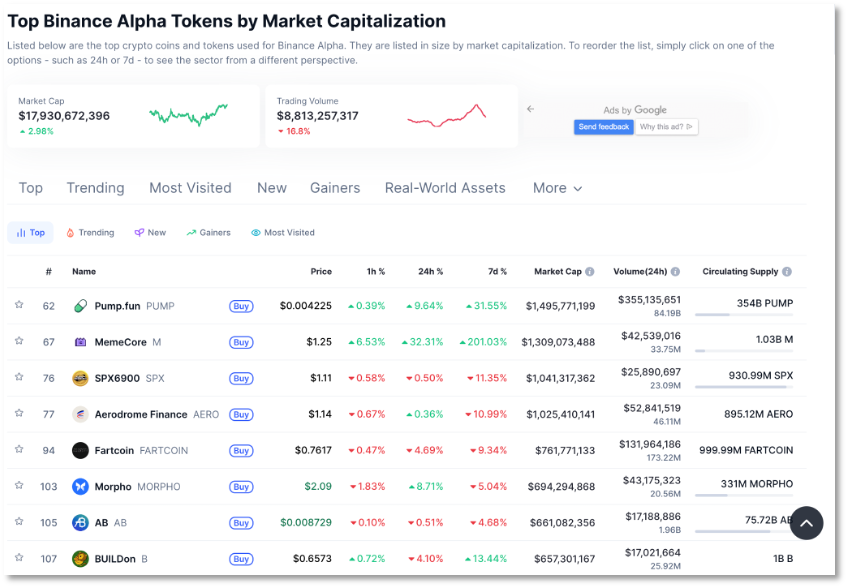
As of September 4, Binance Alpha's trading volume was $8.813 billion.
With high points, traders and point farmers are still present, reminiscent of the situation during Alpha's operation in May and June, accompanied by Binance's dynamic adjustment measures for two consecutive months.
Essentially, Alpha Points are an initiative aimed at rewarding users for actively participating in the Binance ecosystem, officially launched on April 25 of this year. Users accumulate points based on both balance and trading volume, and once they meet the point standards, they can claim new airdrop tokens. Prior to this, some users had keenly captured early opportunities, accumulating a significant amount of token airdrops with only a small amount of trading, quietly amassing over ten thousand dollars in earnings within a month, with a "daily salary" of nearly a thousand dollars.
On the very day the point system was launched, the number of active users on the Binance wallet surged by over 58%—from 44,967 to 71,228, and trading volume also doubled within 24 hours—from $48.46 million to $118 million.
The competition has begun. Binance has been dynamically balancing the reward distribution for participants by iterating the point rules while strengthening risk control to maintain the fairness of the activities.
In May, as the point claim thresholds for Alpha airdrops were seen rising from double digits in April to triple digits, approaching 200 points, on May 13, Binance Alpha's point system was upgraded to include a "consumption mechanism," meaning users need to actually consume 15 points when confirming participation in Alpha or TGE.
Point consumption and lowering thresholds, Binance attempted to adjust the rules towards benefiting contributors, suppressing excessively high points to allow newcomers to "get on board." However, it took nearly half a month for the "point consumption" to truly lower the threshold to around 200 points, roughly corresponding to the 15-day accumulation cycle.
User @Mingo shared his earnings on social media, stating that 24 rounds of Alpha and TGE airdrops earned him $1,795 that month. After deducting $133.5 in trading costs, his "monthly salary" exceeded ten thousand dollars, with the lowest single round earning valued at $70. Among them, the blockbuster project NXPC (Adventure Island) raised many users' single round earnings to $600 or even over a thousand, setting a historical record for Alpha airdrop earnings and undoubtedly becoming @Mingo's highest "daily salary" that month.
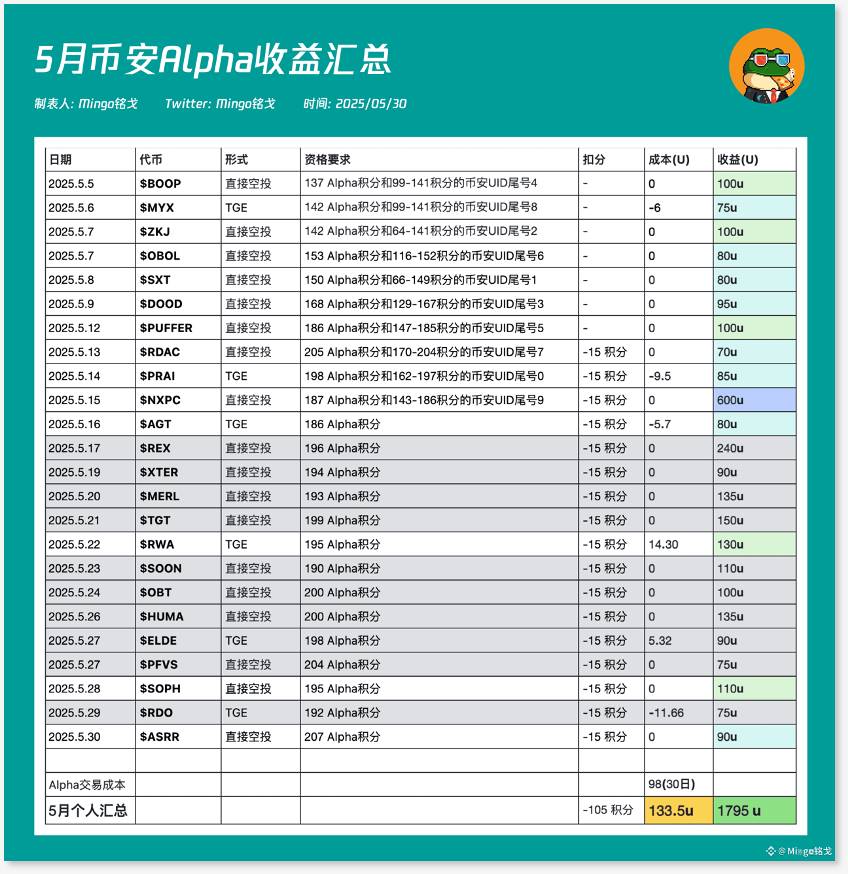
Image from Binance user @Mingo Ming Ge's social media post.
Undoubtedly, the high earnings from early Alpha airdrops are a continuous attraction for users to participate. However, studio teams working together have long been viewed by ordinary users as a major threat to the fairness of Alpha airdrops. Photos of multiple phones competing for Alpha airdrops and recruitment ads for studios seeking dedicated airdrop grabbers have circulated widely on social networks.
In response, Binance initiated a crackdown. In early June, certain teams using bots to participate in Alpha activities were detected by Binance. The company made it clear that any use of bots (including but not limited to scripts, automated tools, or other non-manual methods) would be considered "violations," and it has upgraded its risk control system to enhance the detection and handling capabilities for violations. Accounts triggering risk control will have their eligibility for Alpha points revoked.
On the Binance social section "Square," many users reported receiving violation alerts, with some successfully appealing and others failing.
However, the weekly active users, numbering in the hundreds of thousands, still pushed the point thresholds for directly claiming airdrops in June to between 210 and 251.
Starting June 19, Binance iterated the point rules again, and Alpha airdrops began to adopt a two-phase distribution mechanism. The first phase set a high point threshold for priority claims within a limited time, while the second phase lowered the points to a certain level and distributed them to qualifying users on a first-come, first-served basis.
After the phased point rules were introduced, many users found that claiming/grabbing airdrops required "machine testing," with face recognition and slider verification to prove they were human.
Binance once again strengthened its ability to identify bot cheating, and the Alpha points remained relatively stable in July. In the 31 rounds of Alpha airdrops (excluding TGE), the highest point for "priority claims" was 234, appearing only in the first round of PEAQ airdrops, with single round earnings around $45; the lowest point was 210, occurring in the early rounds of BGSC and RCADE on July 10, with single round earnings around $40; while the "first come, first served" threshold fluctuated between 120-190 points before stabilizing around 200 points.
According to feedback from a user, after accumulating to a high threshold of 240 points, he claimed 5 rounds of airdrops in July, with net earnings around $240 after costs, averaging about $48 per round, which was "significantly lower than the previous two months."
In August, the "first come, first served" threshold, which was almost centered around 200 points, was broken by the end of the month at 230 points, and the internal competition for Alpha airdrops continued. A Dune report indicated that the weekly active users of Binance Wallet transactions had risen from over 120,000 at the beginning of the month to over 180,000 by the end of the month.
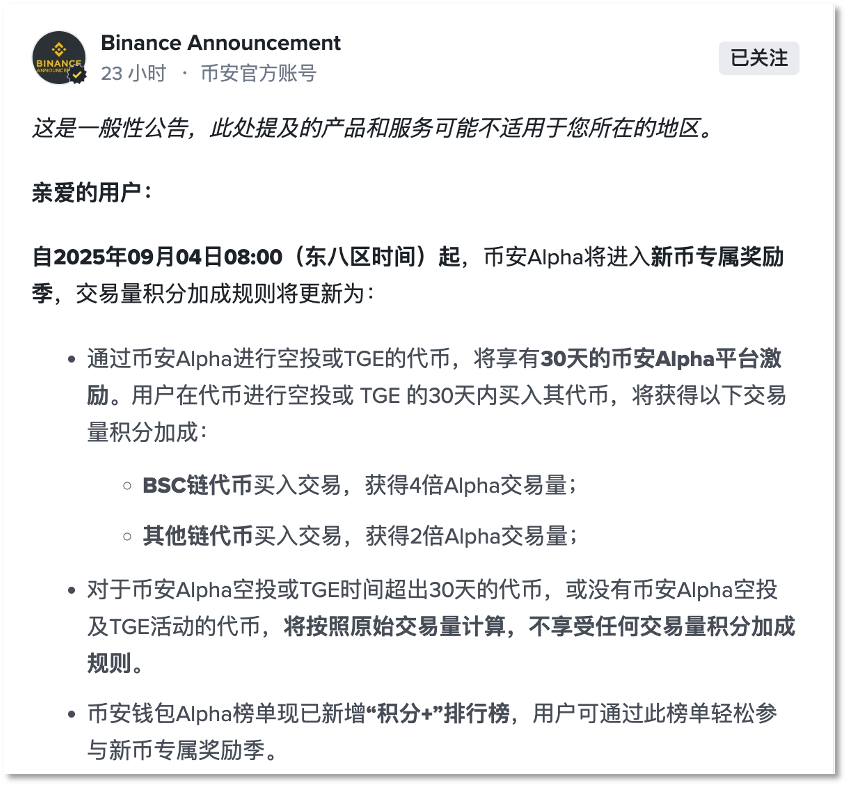
On September 4, Alpha updated the trading volume rules for points.
Finally, on September 4, Alpha adjusted the point rules again, introducing the "Points Plus" feature, which allows for "super doubled" trading volume points for new tokens in airdrops/TGE, providing a trading volume boost within 30 days, while also giving users who are keen on accumulating points and claiming airdrops an "accelerator" to increase point returns.
The "30-day trading volume doubling period" rule, in the view of KOL @BitHappyX, "is a redistribution of resources and benefits": limiting the arbitrage model of studios while directing resources and traffic to real participating users and new projects.
He explained that since old tokens only retain 1x trading volume points, this will cut off the channel for studios to acquire points through large-scale purchases on stagnant old tokens, compressing their arbitrage space; while new tokens enjoy point bonuses, their prices often fluctuate significantly in the first month (within 30 days). Although ordinary users will also face risks, studios pursuing high points and heavily investing will clearly bear higher financial risks.
He predicts that, with insufficient point advantages for old tokens and significantly increased risks for new tokens, some studios will be forced to abandon "false activity" and even directly exit Alpha.
As Winson Liu, the global head of Binance Wallet, emphasized, "Through rewarding participation, we provide a fairer way for truly loyal users of Alpha to engage, while also enabling Binance Alpha to support more quality Web3 projects."
Does the "selection pool" work for Binance listings?
After running for over 8 months, Binance Alpha has distributed over a hundred airdrops. When the trading volume of this segment surpassed $10 billion, the continuously surging trading volume indicated that this ecosystem strongly stimulated user interest, allowing Alpha to form a momentum cycle independent of the traditional altcoin market, continuously validating market projects for Binance through this hard-core metric.
In fact, when Binance announced the launch of Alpha last December, it intended to cultivate this on-chain DEX within the Binance wallet as a new token selection pool for the main site. Although there was no guarantee that Alpha tokens would definitely be listed on the main site, the cases of certain projects conducting exclusive TGEs (Token Generation Events) on the Binance wallet being listed on the main site at the beginning of the year enhanced external perceptions of Alpha as a "token candidate area."
At that time, Binance was troubled by public opinion issues such as "poor listing quality" and "friend tokens," prompting co-founder He Yi to repeatedly respond to doubts, publicly reiterating listing standards and emphasizing "strict selection." Binance also initiated a "vote up/down for listings" rule.
Although Binance later intended to slow down the pace of new listings, the downward trend of most new assets "peaking upon listing" was not effectively improved.
Against this backdrop, Binance Alpha officially "tested the waters," proving that no promise is better than transforming user demands into effective products and experiences, which is what Binance excels at.
On March 18, Binance Alpha 2.0 was born by integrating into the main site, breaking the boundaries between centralized exchanges (CEX) and Web3 wallets, allowing CEX users to directly purchase various emerging early project tokens on-chain using assets like USDT and USDC within the platform.
Winson Liu clearly stated, "The Binance Alpha platform serves as a token selection pool before listings, aiming to enhance the transparency of the listing process on Binance exchange. By publicly recommending selected early projects, the Alpha platform can strengthen community trust and provide users with insights into tokens with future development potential within the Binance ecosystem."
As the number of Alpha tokens increases, the number of projects in the selection pool grows. Will the new listings on the Binance main site explode due to the emergence of new tokens? Have these projects selected by Alpha brought improvements to Binance's listings?
As of September 4, CoinMarketCap recorded a total of 274 token projects listed on Binance Alpha that generated trading. Combining with Binance's official data from August 18 and subsequent updates, 177 of the listed tokens conducted TGE/airdrop/Booster activities, accounting for 64.6%; among them, 26 entered the spot market on the Binance main site, accounting for 14.6%, and 77 were listed on the contract market, accounting for 43.5%.
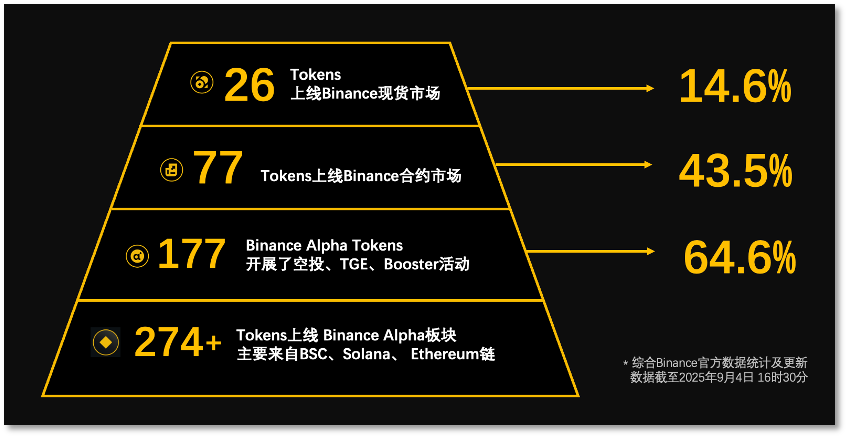
The conversion rate of Alpha airdrop tokens listed on the spot market is 14.6%.
According to statistics from DWF Labs in June, at that time, among the more than 190 tokens in the Binance Alpha segment, 18 were listed on the spot market of the Binance main site, with a conversion rate of 9.5%. After two months, the data shows that out of 274 Alpha tokens, only 26 were listed on the spot market, with a conversion rate still at 9.48%.
It is evident that even with Alpha as a pre-selection pool, Binance has maintained an almost unchanged conversion rate under its "strict selection" standards.
From the Alpha tokens listed on the Binance main site, the vast majority conducted TGE/airdrop/Booster activities, with airdrops being the most frequent and the channel through which tokens were listed on the Binance spot or contract market the most.
Honeypot Tech has compiled statistics on 107 airdrop tokens launched by Binance Alpha from June to September, with a total of 13 tokens listed on the spot market + contract market of the Binance main site, and 19 tokens listed solely on the contract market.
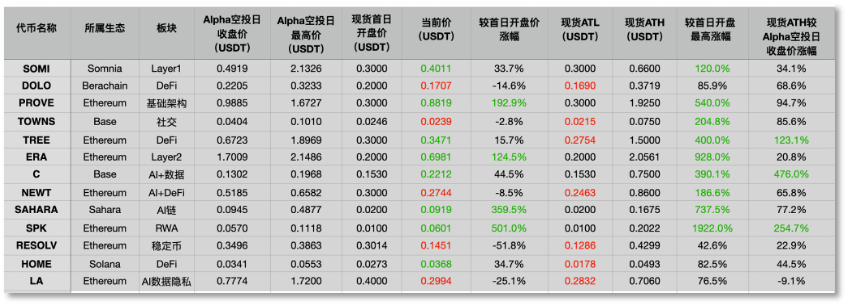
Performance of Alpha airdrop tokens after being listed on Binance spot market
(Data statistics as of September 4, 16:30)
From the trends of these 13 Alpha tokens listed on the Binance spot market, as of September 4, 8 tokens fluctuated with the overall decline in the current cryptocurrency market, but the current prices of PROVE, ERA, SAHARA, and SPK remained strong, still showing increases of 1-5 times compared to their opening prices, with SPK having the highest increase at 501%; only 3 tokens significantly (over 10% drop) fell below their opening prices on the first day, with RESOLV, launched in June, performing the worst, down 51.8% from its issuance price.
Among the 13 projects, 9 tokens' ATH (all-time high) increased by over 100% compared to their opening prices on the first day, with the lowest increase still above 40%. The ATH of PROVE, SAHARA, ERA, and SPK increased by 540%, 737%, 928%, and 1922%, respectively, compared to their respective opening prices on the Binance spot market.
If we take the closing price on the day of the Alpha airdrop as a reference, except for the earliest listed LA (-9.1%), the remaining tokens still managed to create a minimum increase of 20% after being listed on the Binance spot market post-airdrop, with TREE, SPK, and C achieving increases of 123%, 476%, and 245%, respectively, compared to the closing price on the day of the Alpha airdrop, demonstrating Binance's ability to support project tokens.
Such performance of new tokens has greatly surpassed the new projects listed on Binance at the end of last year, breaking the "vicious cycle" of new projects frequently experiencing price drops upon listing on Binance. This indicates that the combination of Alpha and the "airdrop" listing strategy is indeed playing a "selection" effect.
Accelerating towards the core Web3 market
As more projects emerge, the situation of "peaking upon listing" is now appearing in the Alpha trading area. This aligns with the market attributes of Alpha as an emerging Web3 on-chain platform: projects are relatively early, and on-chain liquidity is poor.
But Binance plans to make changes.
First, the new Alpha point rules on September 4 place more emphasis on newly launched projects, which are expected to bring real trading volume from the market, while also amplifying Binance's "one fish, multiple eats" effect.
From the rules, BSC, which occupies the mainstream issuance chain among Alpha tokens, remains a key ecosystem supported by Binance, incentivizing BNBChain with "4x trading volume" (previously unlimited time, 2x), which is expected to increase on-chain activity and fee income; the trading efficiency and price performance of new project tokens in the Alpha trading area may also improve as user trading participation increases.
In addition to improving the trading performance of new tokens from a traffic perspective, on August 28, Binance announced the launch of the Alpha 2.0 limit order market maker program, inviting users with extensive trading experience in DEX to join, offering zero trading fees for limit buy/sell orders and exclusive API access to Alpha.
Binance is leveraging its strategic advantages cultivated over years in CEX to fill the "liquidity" gap for Alpha as a core Web3 market, while its long-standing advantages have gradually become apparent over the past six months.
Since Alpha has attracted a large number of users to participate in trading through airdrops and trading competition rewards, the number of active users on Binance Wallet has already ranked among the top in the global mainstream Web3 wallets. Additionally, most tokens listed on the Binance Alpha platform come from the BNBChain, with 77% of the tokens from the airdrop between June and August originating from BNBChain.
The latest report from Messari on BNBChain for Q2 2025 shows that BNBChain maintained strong growth in the second quarter, with user activity and on-chain transactions reaching all-time highs. Daily active addresses and transaction volumes surged, DeFi activity remained robust, and DEX trading volume, as well as the number of stablecoin transactions and active users, ranked first across all chains, solidifying its leading position in the Web3 ecosystem.
Among them, in terms of market capitalization and investor confidence, BNB's market capitalization increased by 7.5% quarter-on-quarter, reaching $92.6 billion; in terms of on-chain transactions and activity, with fees dropping by 90% to 0.1 gwei, BNBChain's average daily transaction volume increased by 101.9% quarter-on-quarter to 9.9 million transactions, and the average daily active addresses grew by 33.2% to 1.6 million; in May, the number of new addresses reached 17 million; in terms of DEX performance, trading volume ranked first across all chains, with an average daily trading volume of $3.3 billion in Q2, of which PancakeSwap, which undertook a large portion of Alpha's trading matching capacity, held a market share of 85.1%.
Active users, surging traffic, and DEX trading volume are attracting project teams to build on BNBChain. An OG in the crypto asset circle openly suggested in the community that innovative projects should deploy directly on BNBChain, stating, "Low transaction fees and high traffic are what early projects most want to achieve, and BNBChain can almost meet all of that now. Project tokens also have the opportunity to enter Alpha and even receive support from Binance. Why not take advantage of that?"
Winson Liu, the global head of Binance Wallet, believes that the surge in trading volume represents a change in how users interact with Web3, stating, "Binance Alpha is redefining how users discover early projects and receive real rewards—we are setting a new standard for Web3 users to participate preferentially."
As the DEX functionality in the Binance Web3 wallet gradually becomes an important section of the main site, Alpha is developing towards the core product direction of Web3, which is evident from the richness of its interface.
Initially, Alpha was displayed alongside Binance's spot and contract trading functions on mobile; later, due to the introduction of the point system, it had a separate airdrop interface similar to Launchpool; subsequently, this interface not only featured airdrops but also allowed users to access trading competitions, financial management, TGE, and Booster tasks with one click, effectively integrating the features favored by users in the Binance Web3 wallet into a single interface.
Now, users no longer need to enter wallet addresses on third-party websites to calculate accumulated points based on trading volume; Alpha directly provides an estimated value for users' points reference.
Currently, projects landing on Alpha are achieving effects close to being listed on the Binance main site—gaining optimal exposure for projects, capturing strong traffic from top platforms, and obtaining effective market liquidity. Binance Alpha is increasingly taking shape as a core Web3 market. The new rules that double trading volume to deliver points to users also mean that new listings on Alpha will continue, and as this "cake" grows larger, "airdrops" will have the opportunity to become a continuous benefit for users.
免责声明:本文章仅代表作者个人观点,不代表本平台的立场和观点。本文章仅供信息分享,不构成对任何人的任何投资建议。用户与作者之间的任何争议,与本平台无关。如网页中刊载的文章或图片涉及侵权,请提供相关的权利证明和身份证明发送邮件到support@aicoin.com,本平台相关工作人员将会进行核查。




